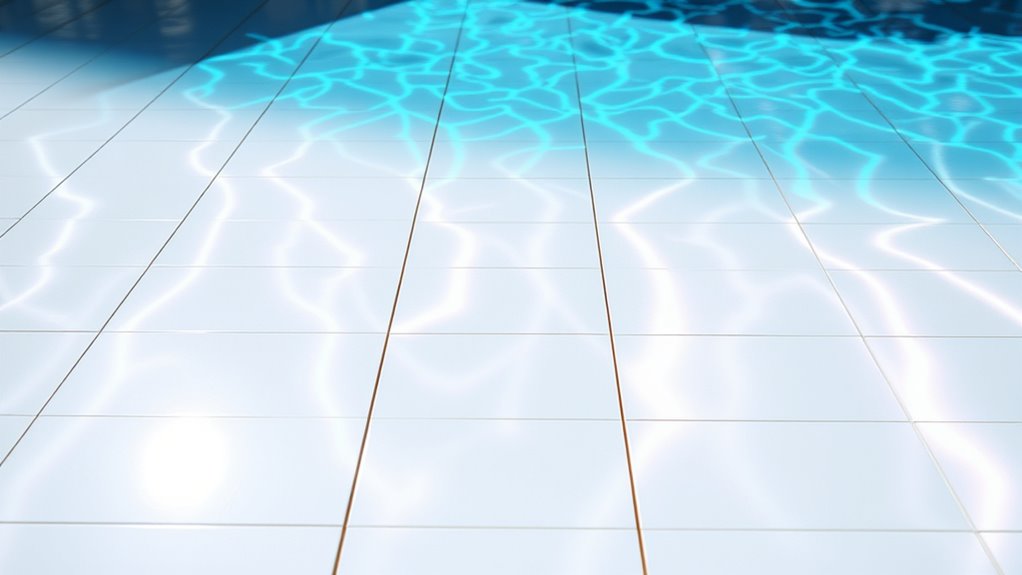White tiles around pools, especially glazed and glossy ones, reflect a lot of UV rays, which can increase your sun exposure unexpectedly. This reflection can bounce UV rays onto your skin even if you’re in the shade or not directly under the sun. Knowing how these surfaces reflect UV helps you take better precautions. Keep in mind that surface type and finish matter—so if you want to stay safe from UV damage, paying attention to these details is key. Learn more to protect yourself effectively.
Key Takeaways
- White tiles, especially glazed or glossy ones, reflect significant UV rays, increasing nearby UV exposure.
- Surface finish and material type influence how much UV radiation is reflected from poolside tiles.
- Reflective white tiles can cause UV rays to bounce onto skin areas not directly exposed to sunlight.
- Higher UV reflection from tiles necessitates more frequent sunscreen application and protective measures.
- Recognizing tile properties helps in assessing UV risk and planning safer outdoor pool environments.

Have you ever wondered how ultraviolet (UV) light interacts with white tiles? When you’re lounging by the pool or walking around a patio, understanding this interaction can help you stay safe and protect your skin. White tiles, especially those made for outdoor use, have unique material properties that influence how they reflect UV rays. These tiles are often chosen for their brightness and clean appearance, but their reflective qualities can considerably increase UV exposure in the surrounding area. Knowing how UV light bounces off these surfaces can help you make better decisions about sunscreen application and overall sun safety.
White tiles tend to have high albedo, meaning they reflect a large portion of UV radiation rather than absorb it. This reflective property is influenced by the tile material, which can range from ceramic and porcelain to natural stone or composite surfaces. Ceramic and porcelain tiles typically have glazed surfaces that enhance their reflectivity, bouncing UV rays in multiple directions. Natural stone tiles, depending on their finish, can also reflect UV light, though often to a lesser degree. The material’s surface texture and glossiness play a role in how much UV is reflected; smoother, glossy surfaces tend to reflect more UV than matte finishes. This increased reflection can lead to higher UV exposure for anyone nearby, especially if you’re spending extended periods in the area. Additionally, the specific material’s reflective properties can vary based on surface treatment and finish.
White tiles with glazed surfaces reflect significant UV radiation, increasing exposure nearby.
When it comes to sunscreen application, understanding these tile properties is vital. If you’re aware that white tiles around the pool reflect considerable UV rays, you might need to reapply sunscreen more frequently than usual, even if you’re in the shade or not directly exposed to sunlight. The reflected UV rays can reach parts of your body that aren’t directly exposed, increasing your risk of sunburn and long-term skin damage. Applying broad-spectrum sunscreen generously and covering all exposed skin becomes even more important in these environments. Don’t forget to reapply every two hours, especially if you’re swimming or sweating, since water and moisture can diminish sunscreen effectiveness.
Being mindful of the tile material properties helps you better understand your environment and how to protect yourself. White tiles aren’t just aesthetically pleasing—they also influence UV reflection, which can boost the amount of UV radiation you’re exposed to. By recognizing this, you can take proactive steps like using protective clothing, seeking shade, and ensuring proper sunscreen application. This knowledge empowers you to enjoy outdoor spaces safely, reducing your risk of UV-related skin issues while still soaking up the sun and enjoying your time poolside.
Frequently Asked Questions
How Does UV Reflection Affect Pool Water Temperature?
UV reflection can slightly increase your pool water temperature by amplifying UV intensity, which heats the water more efficiently. White tiles around the pool reflect UV rays, contributing to this warming effect. While this improves tile aesthetics with their bright, clean look, it also means you might notice a warmer pool over time. Keep in mind, the temperature change is usually subtle but noticeable, especially on hot, sunny days.
Can White Tiles Cause Increased UV Exposure for Swimmers?
A white tile’s like a mirror for UV rays, so yes, it can increase your UV exposure. To guarantee white tile safety, be cautious and wear protective gear, especially during peak sunlight. You can also mitigate UV exposure by applying UV-reflective coatings or installing shaded areas. Remember, an ounce of prevention is worth a pound of cure, so take steps to protect yourself when around reflective white tiles.
Are There Specific White Tile Materials That Reflect More UV Rays?
Certain white tile coatings can reflect more UV rays, especially those with high reflectivity and smooth surfaces. Materials like glazed ceramic or porcelain with glossy finishes tend to reflect sunlight intensities more than matte or textured tiles. If you want to reduce UV exposure, choose tiles with matte or specialized UV-absorbing coatings. Be aware that the reflective properties of white tiles directly influence sunlight intensities, increasing UV exposure for swimmers.
How Can Pool Owners Minimize UV Reflection Hazards?
Your pool area can become a UV safety hotspot if you don’t take precautions. To minimize UV reflection hazards, regularly maintain your tiles by cleaning them and applying UV-resistant coatings. Use shaded areas, wear protective clothing, and apply broad-spectrum sunscreen. Be proactive; otherwise, you’ll risk UV rays bouncing around like a thousand tiny mirrors, endangering your skin and eyes. Proper tile maintenance and safety measures keep your poolside fun safe and worry-free.
Does UV Reflection Impact the Longevity of Pool Tiles?
UV reflection can impact the longevity of your pool tiles by accelerating surface discoloration and potentially weakening tile durability over time. When sunlight reflects off white tiles, it intensifies UV exposure, leading to fading and surface damage. To protect your tiles, consider applying UV-resistant sealants and using shaded areas or awnings. Regular maintenance and choosing durable, UV-resistant tiles can also help preserve your pool’s aesthetic and structural integrity.
Conclusion
As you stand by the pool, the white tiles reflect UV rays like tiny mirrors, intensifying the sunlight’s strength. It’s a stark contrast—the inviting blue water beckons relaxation, yet the dazzling glare from the tiles reminds you of the hidden risks lurking beneath. While the pool offers a cool escape, the reflective surfaces amplify UV exposure, urging you to protect your skin. Embrace the beauty, but stay mindful of the bright, unforgiving reflection that surrounds you.









